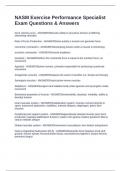NASM Exercise Performance Specialist
Exam Questions & Answers
force velocity curve - ANSWERSMuscles ability to prouduce tension at differing
shortening velocities
Rate of Force Production - ANSWERSHow quickly a muscle can generate force
concentric contraction - ANSWERSDeveloping tension while a muscle is shortening
eccentric contraction - ANSWERSmuscle lengthens
Isometric - ANSWERSWhen the contractile force is equal to the resistive force, no
movement
Agonists - ANSWERSprime movers, primarily responsible for producing a particular
movement
Antagonists muscles - ANSWERSoppose the action of another (i.e. biceps and triceps)
Synergists muscles - ANSWERSAssist prime mover muscles
Stabilizers - ANSWERSsupport and stabilize body while agonists and synergists create
movement
Behavioral properties of muscle - ANSWERSextensibility, elasticity, irritability, ability to
develop tension
local muscular system - ANSWERSstabilization system; muscles connect directly to
spine; transverse abdominis, multifidus, internal obliques, diaphragm, pelvic floor
muscles
Peripheral joint support system - ANSWERSappendicular skeletal muscle; poor force
production; isolated stabilization function; rotator cuff, gluteus medius (posterior fibers),
vastus medialis oblique
Global muscular system - ANSWERSmovement musculature; four distinct subsystems
Deep Longitudinal Subsystem (DLS) - ANSWERStransmits force between trunk and
ground; erector spinae, thoracolumbar fascia, sacrotuberous ligament, biceps femoris,
peroneus longus
, Posterior Oblique Subsystem (POS) - ANSWERStransfers force from transverse to
sagittal plane; works synergistically with DLS; important for rotational activities;
latissimus dorsi and contralateral gluteus maximus, cross-body bridge through
thoracolumbar fascia
Anterior Oblique Subsystem (AOS) - ANSWERSsimilar to POS on front side of body;
internal and external obliques, adductor complex, hip external rotators
Lateral subsystem - ANSWERSfrontal plane and pelvo-femoral stability; gluteus
medius, tensor fascia latae, adductor complex, quadratus lumborum
subjective information - ANSWERSpersonal information given by the athlete; medical
history and lifestyle
Readiness for activity - ANSWERScollect medical history, such as past injuries,
surgeries, illness, medications, and chronic conditions before training a new athlete
Past injuries - ANSWERSprior injuries can have effects up and down the kinetic chain;
most importantly ankle sprains, and injuries to knee ligaments, the low back, and the
shoulders
objective information - ANSWERSMeasurable data about a client's physical state such
as body composition, movement, and cardiovascular ability
physiological assessment - ANSWERSresting heart rate, blood pressure, body
composition
resting heart rate - ANSWERS70 BPM for average adult.. can range from 60-100bpm
blood pressure - ANSWERSNormal systolic = 120-130mmHg; normal diastolic = 80-
85mmHg
Body composition assessment - ANSWERSSkin fold calipers, circumference
measurements, bioelectrical independence, underwater weighing, whole body
plethysmography, DEXA
How to get fat mass? - ANSWERSBody fat % x scale weight
How to get lean mass? - ANSWERSScale weight - fat mass
Circumference Measurements - ANSWERSassess girth changes in the body; not
accurate estimate of fatness.
Measure at the neck, chest, waist, hips, calves, and biceps.




